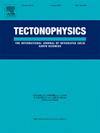Bathymetric and structural insights into the Islas Marías Archipelago, Mexico, and surrounding areas
IF 2.7
3区 地球科学
Q2 GEOCHEMISTRY & GEOPHYSICS
引用次数: 0
Abstract
The Islas Marías Archipelago is located south of the Gulf of California. This study presents a structural geologic analysis of María Madre Island, coupled with a detailed bathymetric survey of the surrounding area. Our goal is to delineate the deformation geometry and identify new morphostructural features in the region. Bedding tilting coincided with normal faulting of the lower member of the Ojo de Buey sequence, likely at the end of the Pliocene or the beginning of the Pleistocene, associated with the early stage of the Gulf of California rifting. Seismic reflection profiles from previous studies indicate that the West Ranges are within a thinned continental crust, structurally controlled by the María, Magdalena, and South Magdalena faults. Furthermore, a detailed bathymetric survey and orthoimages from the islands revealed structural lineaments in both oceanic and continental crust. In the continental crust, these lineaments have a preferred orientation between 050° to 090°, similar to the faulting trend on María Madre Island. However, they are oblique to those in the oceanic crust and mainland Mexico. We propose that María Madre Island may have undergone a 50° clockwise rotation. If we apply a counterclockwise rotation of this magnitude to the faults and lineaments in the continental crust of the archipelago and the region west of it, their preferred orientation becomes parallel to the Tamayo Fracture Zone in the oceanic crust, the San Blas fault within the continental shield and, the Tepic-Zacolaco rift extending eastward into mainland Mexico. This suggests that rotation affected the continental crust, either west of Puerto Vallarta, in the archipelago, or the West Ranges, while the oceanic crust remained relatively unaffected. We propose the term “Islas Marías Block” to designate a fragment of continental crust encompassing the archipelago and the West Ranges, which share a common deformation style.

对Islas Marías群岛,墨西哥和周边地区的深度和结构见解
Marías群岛位于加利福尼亚湾南部。本研究对María Madre岛进行了构造地质分析,并对周围地区进行了详细的水深测量。我们的目标是描绘该地区的变形几何形状并确定新的形态结构特征。层理倾斜与Ojo de Buey层序下段的正断层重合,可能发生在上新世末期或更新世初期,与加利福尼亚湾裂陷的早期阶段有关。先前研究的地震反射剖面表明,西山脉位于一个薄的大陆地壳内,在结构上受María、Magdalena和South Magdalena断裂控制。此外,详细的水深测量和来自岛屿的正射影显示了海洋和大陆地壳的结构轮廓。在大陆地壳中,这些构造倾向于在050°~ 090°之间,与María Madre岛的断裂走向相似。然而,它们是斜向那些在海洋地壳和墨西哥大陆。我们提出María马德雷岛可能经历了50°顺时针旋转。如果我们对群岛大陆地壳及其以西地区的断层和地貌进行这种程度的逆时针旋转,它们的首选方向将与海洋地壳中的塔马约断裂带、大陆盾内的圣布拉斯断层以及向东延伸至墨西哥大陆的特皮克-扎科拉克裂谷平行。这表明,旋转影响了大陆地壳,要么是群岛中的巴亚尔塔港以西,要么是西山脉,而海洋地壳相对未受影响。我们提出“Islas Marías地块”一词来指定一个包含群岛和西山脉的大陆地壳碎片,它们具有共同的变形风格。
本文章由计算机程序翻译,如有差异,请以英文原文为准。
求助全文
约1分钟内获得全文
求助全文
来源期刊

Tectonophysics
地学-地球化学与地球物理
CiteScore
4.90
自引率
6.90%
发文量
300
审稿时长
6 months
期刊介绍:
The prime focus of Tectonophysics will be high-impact original research and reviews in the fields of kinematics, structure, composition, and dynamics of the solid arth at all scales. Tectonophysics particularly encourages submission of papers based on the integration of a multitude of geophysical, geological, geochemical, geodynamic, and geotectonic methods
 求助内容:
求助内容: 应助结果提醒方式:
应助结果提醒方式:


